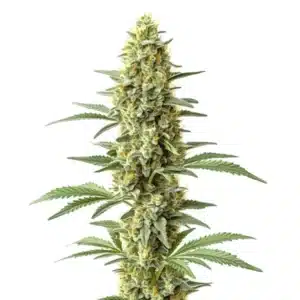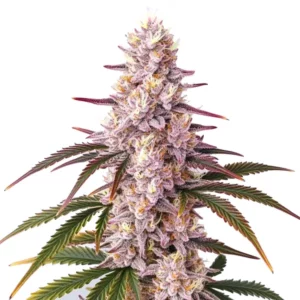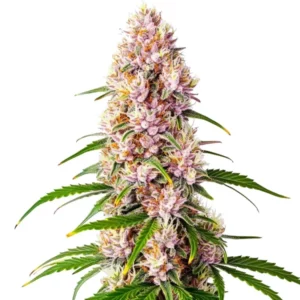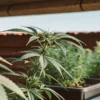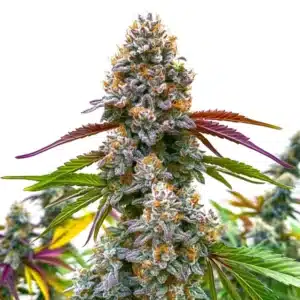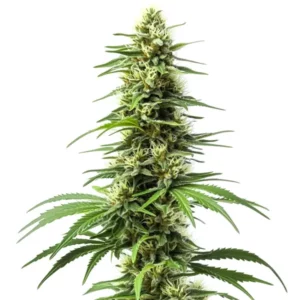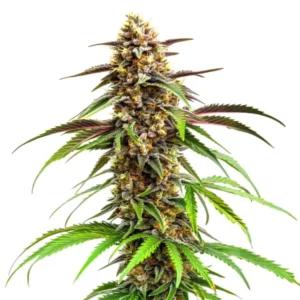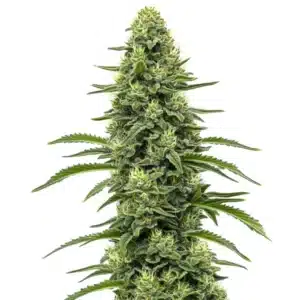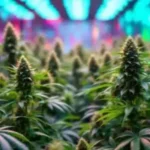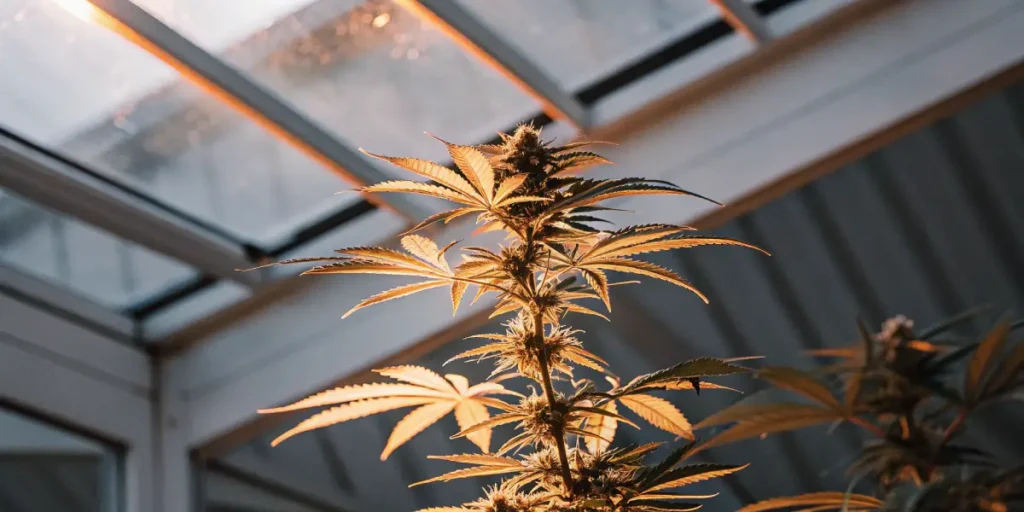
LED vs HPS: Impact on Cannabis Photoreceptors
When it comes to cannabis cultivation, lighting plays a pivotal role. The debate often centers on LED vs HPS: Impact on Cannabis Photoreceptors, since each lighting system affects growth and yield differently. LEDs are known for energy efficiency and spectrum control, while HPS lights deliver intense brightness and deep canopy penetration. Choosing the right option can make a significant difference in your grow room results.
LEDs, or light-emitting diodes, are known for efficiency. They produce less heat and consume less electricity. This can lead to lower operational costs. On the other hand, HPS (High Pressure Sodium) lamps have been the traditional choice for many growers, known for their strong light output.
Recommended Strains
Blue Dream
|
|
THC | 17% - 24% (Medium) |
|
|
Type | Feminized |
|
|
Yield | High |
|
|
Phenotype | 50% Indica / 50% Sativa |
Z OG
|
|
THC | 16% - 20% (Medium) |
|
|
Type | Feminized |
|
|
Yield | Medium |
|
|
Phenotype | 75% Indica / 25% Sativa |
Let’s dig deeper into how these lighting systems affect cannabis photoreceptors. By comparing LED and HPS for cannabis cultivation, we can identify which is best for your growing needs. Practical examples and real-life results will aid your decision-making process.
LED Lighting Effects on Cannabis Growth
LED lighting has revolutionized indoor growing. These lights offer a spectrum that can be tailored to specific stages of growth. This flexibility is crucial for optimizing cannabis yield differences under LED and HPS lighting.
For instance, LEDs can be adjusted to emit more blue light during the vegetative stage. Blue light encourages bushier growth, which is ideal for strains like Blue Dream from Blimburn Seeds. This adaptability is a significant advantage over traditional lighting systems.
Moreover, LED lighting effects on cannabis growth are evident in the plant’s morphology. The precise control over light intensity and spectrum allows growers to fine-tune the environment, promoting healthier and more resilient plants. This is particularly beneficial for indoor setups where environmental factors can be meticulously managed. Studies comparing LED vs HPS: Impact on Cannabis Photoreceptors show that LEDs can enhance photosynthetic efficiency, improve bud quality, and reduce energy consumption compared to traditional HPS systems.
Additionally, the reduction in heat output from LEDs minimizes the risk of heat stress, allowing plants to thrive even in smaller grow spaces. This not only improves plant health but also reduces the need for extensive cooling systems, thereby lowering operational costs and improving sustainability.
- Lower energy consumption with LEDs
- Reduced heat output
- Customizable light spectrum
LED’s Influence on Photoreceptors
Photoreceptors in cannabis plants respond differently to LED lighting. Blue and red spectrums are vital for various growth stages. LEDs can provide these spectrums efficiently, enhancing the plant’s ability to photosynthesize.
Strains like Z OG benefit from LEDs because the light can be optimized for resin production. This results in higher potency and flavor. The photoreceptor response in cannabis to LED vs HPS lighting can affect the quality of your harvest.
Furthermore, the ability of LEDs to mimic natural sunlight conditions through spectrum adjustments makes them a powerful tool for enhancing plant metabolism. This can lead to improved nutrient uptake and overall plant vigor, contributing to a more robust growth cycle.
LED lighting’s influence on photoreceptors is also reflected in the plant’s ability to adapt to stress. By optimizing light conditions, growers can fortify their plants against environmental stresses, resulting in a more resilient crop that can withstand fluctuations in temperature and humidity.
Promos & Deals
HPS Lamps Impact on Cannabis Photoreceptors
HPS lamps have a long-standing reputation. They emit a broad spectrum, with a strong emphasis on the red spectrum. This is beneficial during the flowering stage, promoting better bud development.
However, they can generate significant heat. This requires careful management to prevent stress on the plants. Despite this, many growers love the robust yields that HPS lighting can produce.
In terms of HPS lamps’ impact on cannabis photoreceptors, the intense light output can drive photosynthesis to higher levels, potentially leading to explosive growth during the flowering phase. This can be particularly advantageous for growers aiming for maximum yield.
Nevertheless, the high heat emissions from HPS lighting necessitate advanced ventilation and cooling solutions to maintain optimal growing conditions. This can add complexity and cost to the cultivation process, factors that need to be weighed against the potential benefits.
- High light output, ideal for flowering
- Proven track record in commercial grows
- Higher heat generation compared to LEDs

Photoreceptor Response to HPS
Cannabis plants have specific photoreceptors that react to red light, such as phytochromes. These are crucial during flowering. HPS lamps are effective at stimulating these receptors, leading to larger buds.
For cultivators growing strains like Amnesia Haze, HPS lighting can result in impressive yields. However, managing heat is critical to avoid burning the plants. This means investing in good ventilation systems.
Additionally, the photoreceptor response to HPS lighting can influence the plant’s developmental timeline. The abundant red light can expedite flowering, allowing for a quicker turnaround and potentially more harvests per year.
However, growers must balance this accelerated growth with the potential for heat stress, which can impede the plant’s ability to reach its full genetic potential. Proper management is key to harnessing the full benefits of HPS lighting.
Comparing LED and HPS for Cannabis Cultivation
The decision between LED and HPS lighting depends on several factors. Cost, energy consumption, and expected yield are just a few. Each lighting type offers unique benefits that cater to different growing conditions.
LEDs are excellent for beginners due to their energy efficiency and lower heat output. Meanwhile, HPS lamps might be preferred by those seeking high yields and have experience managing indoor environments.
When comparing LED and HPS for cannabis cultivation, it’s crucial to consider the specific needs of the strains being grown. Some strains may thrive under the customizable spectrum of LEDs, while others might excel with the intense light of HPS lamps.
Moreover, the environmental impact of each lighting type should also be taken into account. LEDs generally have a lower carbon footprint due to their energy efficiency, making them a more sustainable choice for eco-conscious growers.
- LEDs are cost-effective long-term
- HPS provides strong yields but may cost more in electricity
- Consider the growth stage when choosing lights
Cannabis Yield Differences Under LED and HPS
Yield is a vital consideration for any grower. LEDs can produce comparable yields to HPS if used correctly. The key is in the spectrum and intensity adjustments that LEDs allow.
For example, strains like Critical Daddy Purple may yield differently under each type of light. With LEDs, you can focus on resin and terpene production, while HPS might offer bulkier buds.
In examining cannabis yield differences under LED and HPS, it’s important to note that the quality of the yield can vary significantly. LED-grown cannabis often boasts higher concentrations of terpenes and cannabinoids, enhancing the plant’s therapeutic and recreational value.
Conversely, HPS lighting may produce larger colas and denser buds, appealing to growers prioritizing volume. Ultimately, the choice between LED vs HPS: impact on cannabis photoreceptors will depend on whether the grower values quantity or quality.

FAQ Section
What are the main differences between LED and HPS lighting for cannabis?
The main differences between LED and HPS lighting lie in energy consumption, heat output, and spectrum flexibility. LEDs are more energy-efficient and produce less heat, making them suitable for smaller grow spaces. They also allow for spectrum customization, which can be tailored to different growth stages.
On the other hand, HPS lights are known for their high light output, particularly in the red spectrum, which is beneficial during the flowering stage. However, they consume more electricity and generate more heat, requiring efficient cooling systems to prevent stress on the plants.
Considering the LED vs HPS: impact on cannabis photoreceptors, both systems offer unique advantages. LEDs provide precise control over light conditions, while HPS lamps deliver intense, consistent lighting that can boost yields during flowering.
Ultimately, the decision between LED and HPS will depend on the grower’s specific goals, experience level, and available resources. Each lighting type caters to different priorities, whether it’s energy efficiency or maximizing yield.
How do LEDs affect cannabis photoreceptors?
LEDs influence cannabis photoreceptors by providing specific light spectrums that enhance photosynthesis and growth. Blue light from LEDs is essential during the vegetative stage, promoting bushy and compact growth. This helps in developing strong and healthy plants.
Red light from LEDs is crucial during flowering, enhancing bud development and resin production. By adjusting the spectrum, growers can optimize the plant’s response, improving yield quality and potency.
Additionally, the flexibility of LED lighting effects on cannabis growth enables growers to adapt their setup to the plant’s changing needs throughout its lifecycle. This dynamic capability can lead to significant improvements in overall plant health and resilience.
The targeted light spectrum offered by LEDs also supports a more balanced growth environment, reducing the likelihood of nutrient deficiencies and other stressors that can impede the plant’s development.
Are there any strains that perform better under LED lighting?
Some strains, such as Blue Dream and Zkittlez, may perform exceptionally well under LED lighting due to the spectrum’s ability to enhance resin and terpene production. The adjustable spectrum allows for better control over growth stages, ultimately affecting the plant’s flavor and potency.
LED lighting is particularly beneficial for strains that require specific light conditions or are sensitive to heat, as it produces less heat compared to HPS lamps.
Furthermore, the adaptability of LEDs makes them suitable for experimenting with various strains, allowing growers to fine-tune their approach to maximize the genetic potential of each plant.
With the precise control that LEDs offer, growers can explore a wider range of cultivation techniques, potentially unlocking new characteristics in well-known strains or developing unique phenotypes tailored to specific growing conditions.
Why might a grower choose HPS over LED lighting?
A grower might choose HPS lighting if they prioritize high yields and have the necessary infrastructure to manage the heat output. HPS lights are known for their effectiveness during the flowering stage, producing robust and dense buds.
Experienced growers who can manage the heat and electricity costs may find HPS lighting beneficial, especially for strains that thrive under intense light conditions, like Amnesia Haze.
HPS lamps impact on cannabis photoreceptors by delivering a powerful and consistent light source that can drive significant yield improvements. This makes them an attractive option for commercial operations focused on maximizing output.
However, the decision to use HPS lighting should also consider long-term energy costs and the potential need for additional cooling equipment, which can impact the overall feasibility of this approach for smaller-scale growers.
Can HPS lighting impact the flavor of cannabis?
HPS lighting can influence the flavor profile of cannabis by affecting the plant’s terpene production. The intense red spectrum can enhance certain characteristics, leading to flavor variations compared to LED-grown plants.
While HPS lighting is excellent for maximizing yields, it’s crucial to consider the desired flavor and aroma of the final product. This can be crucial for growers focused on producing cannabis with specific taste profiles.
The photoreceptor response in cannabis to LED vs HPS lighting can also play a role in the plant’s final flavor and aroma. The choice of lighting can subtly influence the chemical composition of the plant, affecting its sensory qualities.
Growers aiming for a particular flavor profile may need to experiment with both lighting types to find the optimal balance between yield, potency, and taste, ensuring that the end product meets their specific goals.




